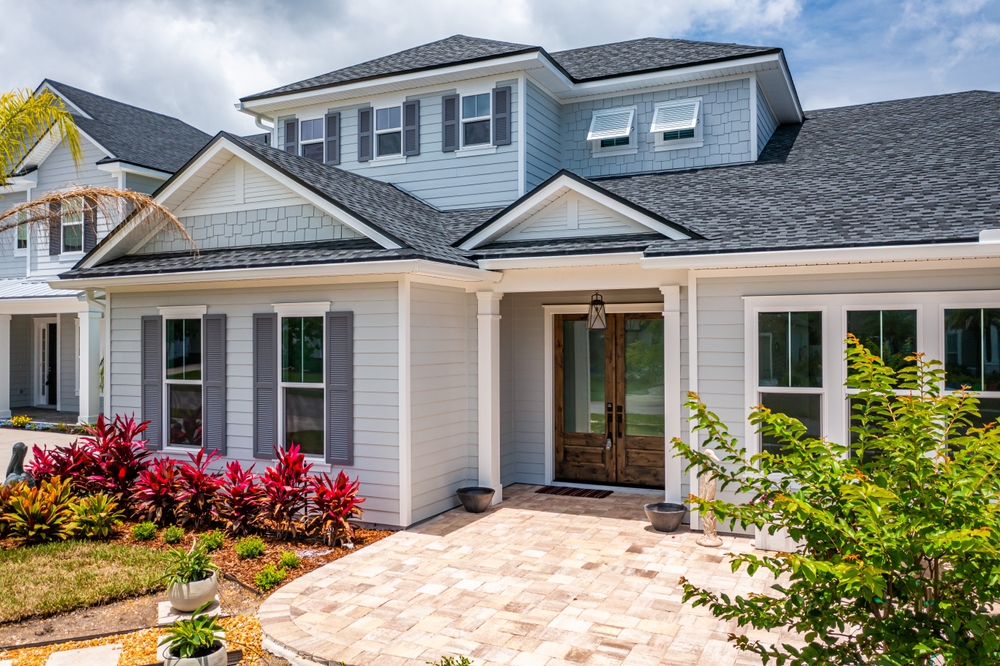New construction homes give buyers room to dream about stylish custom layouts, smart energy features, and a clean slate to make their own. But as appealing as these perks are, that blank canvas can come with a bigger price tag, especially when it comes to monthly payments. For current homeowners looking to improve their living situation, is it better to renovate and fall back in love with your current space, or to sell and move into something brand new?
With interest rates high, homeowners—especially those with growing families or changing needs—are increasingly choosing to improve their current homes rather than move. This trend is reflected in record levels of investment in residential improvements and fewer ‘For Sale’ signs.
To better understand how the cost of buying new affects today’s homeowners, researchers at Inspired Closets, a company specializing in custom home storage solutions, looked at the numbers behind new construction prices. The study examines the increasing cost of new construction homes and how prices have changed over time. It compares estimated monthly mortgage payments for new construction to the monthly payments reported by existing homeowners. Finally, it identifies the most expensive and affordable cities for buying new—both in absolute terms and relative to current owners’ costs.
Using the latest available data from Zillow and the U.S. Census Bureau, researchers found that in Q1 2025:
- Median price of a new construction home: $429,993
- Median estimated value of an existing home (by its owner): $387,817
- Price gap: ~$42,000 or 11% — down from 30% in 2018
While the cost difference between new and existing homes is shrinking, the monthly payment gap has grown significantly due to higher interest rates.
- 2018 monthly payment for new home: ~$1,327
- 2025 monthly payment for new home: ~$2,243
- 2025 monthly payment for existing homeowner: ~$1,574
How Much Does It Really Cost to Buy a New Home?
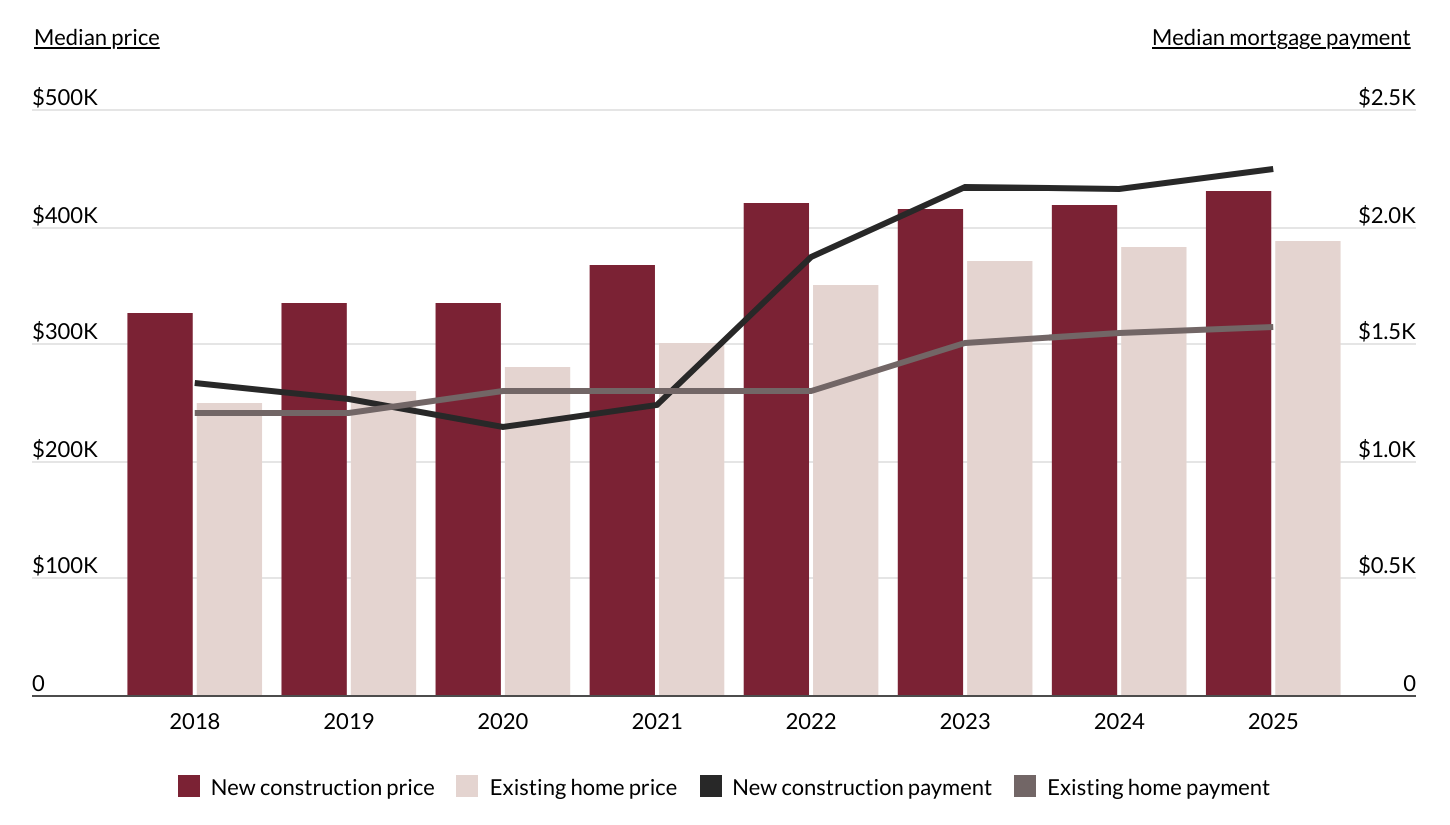
Source: Inspired Closets analysis of Zillow and Census Bureau data
In Q1 2025, the median sale price of a new construction single-family home reached $429,993. By comparison, existing homeowners estimated that their single-family homes would sell for a median price of $387,817, according to survey data from the U.S. Census Bureau’s American Community Survey (ACS). This represents a gap of roughly 11%—down significantly from 2018, when the gap stood at about 30% ($325,764 for new homes versus $250,000 for existing homes). New construction homes still come with a higher price tag, but the shrinking gap shows just how much the housing market—and what buyers are looking for—is starting to shift.
In recent years, homebuilders have started designing smaller, more affordable homes to match what today’s buyers are looking for. This shift has helped the slow rise in new home prices compared to the rest of the market. But even with prices leveling out, the monthly cost of owning a new home has not.
Thanks to higher mortgage rates, monthly payments for new buyers have climbed steeply. Back in 2018, someone buying a median-priced new home paid around $1,327 each month, only slightly more than the $1,200 paid by existing homeowners. But by 2025, that gap had widened dramatically. New construction buyers now pay an average of $2,243 a month, compared to $1,574 for those who’ve owned their homes for years.
Even though homes aren’t selling for much more than their asking prices these days, the high interest rates have bumped up the monthly costs of stepping into something new.
New Construction Home Prices by City
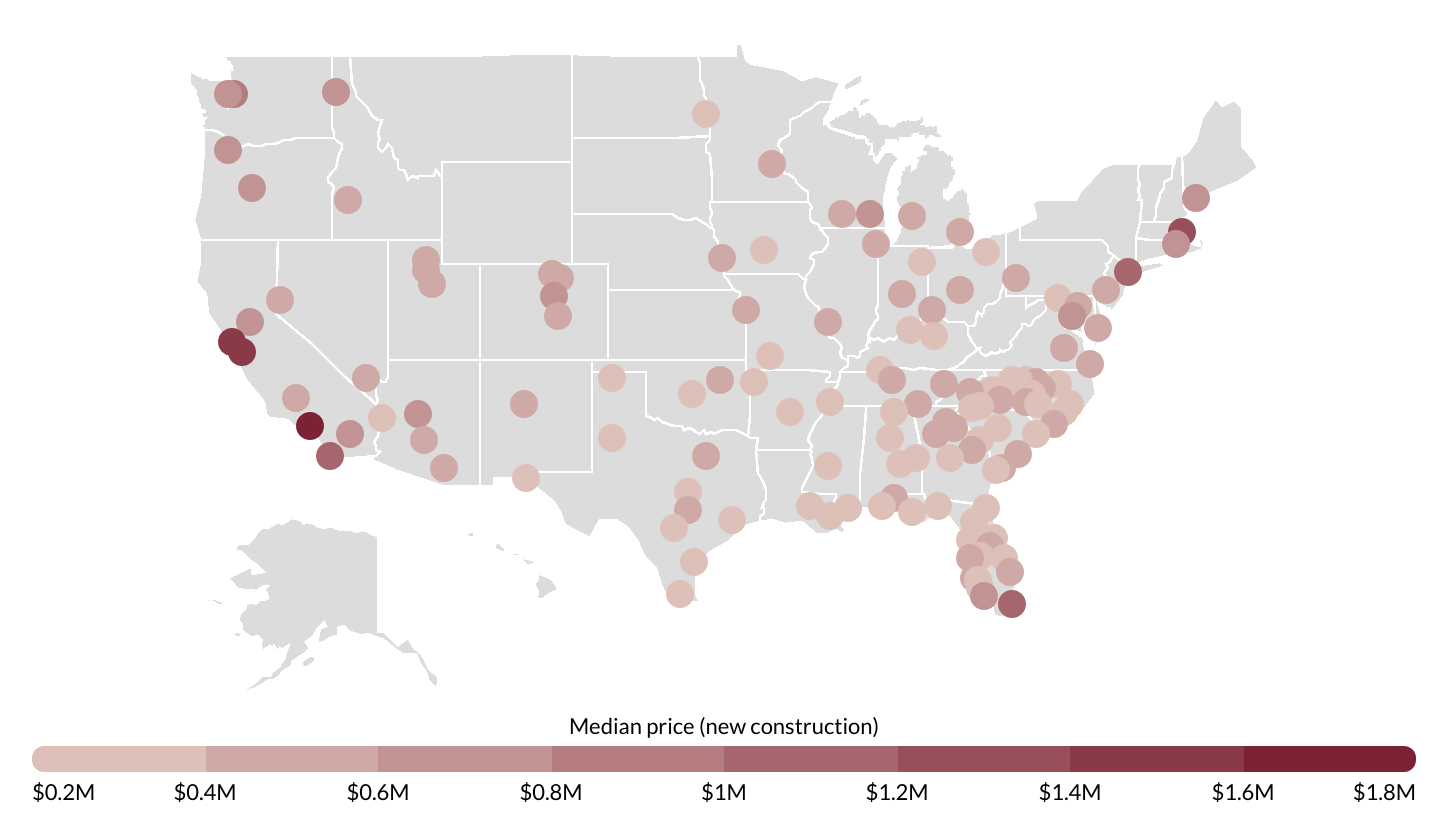
Source: Inspired Closets analysis of Zillow and Census Bureau data
From coast to coast, the dream of buying new looks different depending on where you live and what you’re dreaming of. New construction home prices vary widely across the U.S., with the highest prices concentrated in coastal regions and the lowest prices found in parts of Texas, Florida, and the Southeast.
Among the nation’s largest housing markets, the most expensive is Los Angeles, CA, where the median sale price for a new construction single-family home was nearly $1.8 million in the first quarter of 2025. Other metros that topped the $1 million mark include San Francisco, CA ($1,571,667), San Jose, CA ($1,501,667), Boston, MA ($1,355,387), San Diego, CA ($1,198,014), New York, NY ($1,139,833), and Miami, FL ($1,068,983). In these markets, high demand, limited space to build, and rising construction costs all push prices higher—especially as more buyers look for premium, top-tier homes that check every box.
In contrast, the lowest median prices for new construction are found in metros across Texas, Florida, and the South. McAllen, TX reported the lowest median price at $260,467, followed by Homosassa Springs, FL ($272,383), Ocala, FL ($284,748), San Antonio, TX ($285,626), and Spartanburg, SC ($292,196). These markets benefit from more developable land and fewer regulatory constraints, which keep construction costs lower. Developers in these areas also focus on affordability, offering homes designed to meet the needs of cost-conscious buyers.
The Cost of Upgrading to a New Construction Home by City
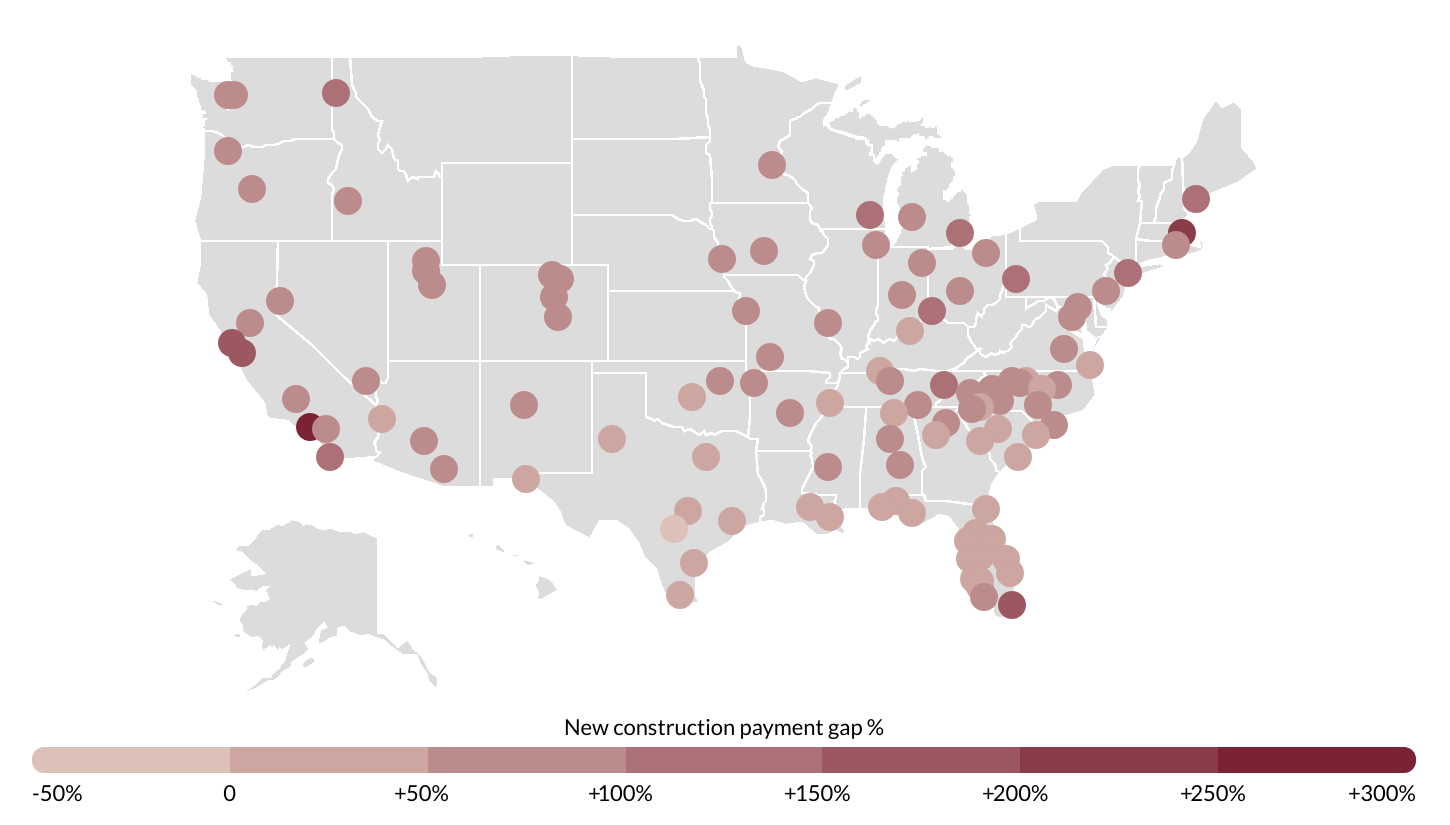
Source: Inspired Closets analysis of Zillow and Census Bureau data
While new construction homes typically come with higher price tags, the larger obstacle for many would-be buyers today is the monthly mortgage payment. Researchers looked at how much buyers today would pay each month for a new home compared to what existing homeowners are already paying, assuming a 30-year fixed mortgage with 20% down at current rates, and the gap may surprise you. The results help explain why more homeowners are choosing to refresh their current homes instead of purchasing new.
The largest relative payment gaps are concentrated in high-cost metros, where housing demand remains strong and many current homeowners are still benefiting from historically low interest rates. In Los Angeles, CA, the median monthly mortgage payment for a new construction home is $9,233, compared to $2,413 for existing homeowners—a 282.6% increase, or an additional $6,820 per month. Similar gaps are observed in other prominent coastal hubs like Boston, MA (+206.2%), San Francisco, CA (+189.3%), San Jose, CA (+166.6%), Miami, FL (+165.7%), San Diego, CA (+148.1%), and New York, NY (+126.6%).
Even in more affordable areas, the jump in monthly cost can still be steep for buyers considering a new build. In Milwaukee, WI, for instance, the estimated new construction payment is $3,233, more than double the $1,364 paid by existing homeowners. Several metros across the Midwest and South—including Detroit, MI, Pittsburgh, PA, Knoxville, TN, and Cincinnati, OH—also show percentage increases of over 100%. San Antonio stands out as the only major city where new construction could actually cost less each month than what current homeowners are paying. This is partly driven by new construction homes in San Antonio priced below their market average.
It all comes down to a mix of past mortgage rates and today’s home prices. Most existing homeowners secured lower interest rates during the 2020–2021 period, while potential new-construction buyers face higher borrowing costs. So even if the sticker price looks similar, the jump in monthly payments can be much bigger than expected, making it harder for buyers to take that next step.
For a complete breakdown of how the price of new construction compares across more than 100 of the largest housing markets in the U.S., see the original post at Inspired Closets: Thinking About Buying New? Here’s What a New Construction Home Costs Across the U.S.
Methodology
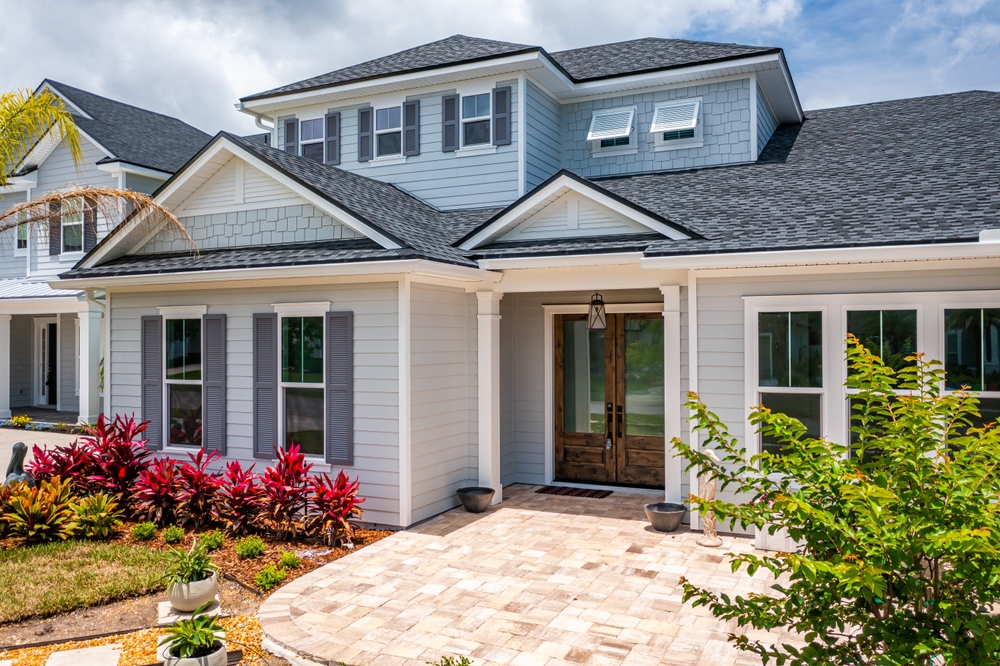
Photo Credit: Photos By The Owl / Shutterstock
This study analyzed the cost of new construction single-family homes across metropolitan areas in the United States using data from Zillow and the U.S. Census Bureau’s American Community Survey (ACS). The primary goal was to compare the prices and mortgage payments for new construction single-family homes with those of existing single-family homes.
To estimate the current price of new construction homes, researchers used Q1 2025 median sale price data for new construction single-family homes sourced from Zillow. These figures were then compared to data from the 2023 ACS—the latest available—which asked single-family homeowners with mortgages to estimate how much their home would sell for if it were listed. Since the ACS data reflects 2023 valuations, researchers adjusted these figures to 2025 levels using metro-specific home price appreciation data.
Researchers also estimated monthly mortgage payments for new construction homes. These hypothetical payments assumed a 30-year fixed-rate mortgage at 6.8% interest with a 20% down payment. These estimates were then compared to the actual monthly mortgage payments reported by existing single-family homeowners in the ACS. Reported payments were adjusted to 2025 dollars using CPI data to ensure comparability.
The final analysis includes both the absolute dollar differences and percentage gaps between new construction and existing homes, measured across home prices and monthly mortgage payments. Only metropolitan statistical areas with complete data from both sources were included in the final dataset.
For complete results, see Thinking About Buying New? Here’s What a New Construction Home Costs Across the U.S. on Inspired Closets.




